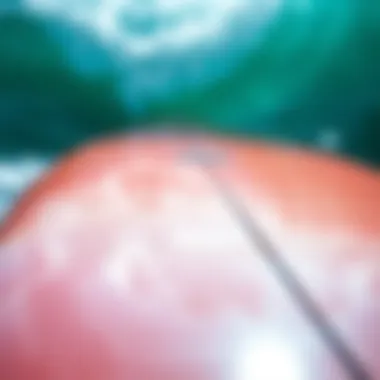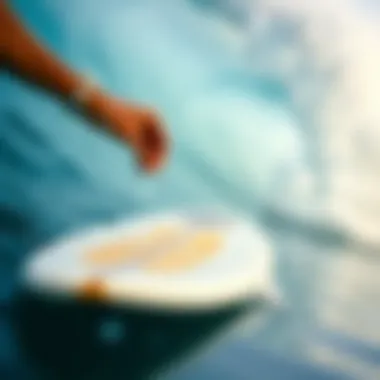Mastering Surf Wax Removal: Techniques and Tips


Intro
Keeping a surfboard in prime condition is key for any surfer looking to make the most of their time on the waves. One of the more subtle aspects of surfboard maintenance is the removal of surf wax, which can greatly influence your board's performance and integrity. Ignoring this task can lead to diminished grip, potentially unsafe rides, and shorter lifespans for our beloved boards. In this guide, we’ll roll up our sleeves and dig into the nitty-gritty of surf wax removal, breaking down effective techniques, the science behind the wax itself, and tips for preserving your equipment long-term.
Techniques and Skills
When it comes to removing surf wax, technique is everything. While it may seem straightforward, a methodical approach can ensure that you keep your board in shape while successfully getting rid of that stubborn wax.
Choosing the Right Tools
Before diving into the wax removal process, having the right tools on hand is crucial. Here’s a brief rundown of what you’ll need:
- Wax Comb: A standard tool for surf wax removal, designed to efficiently scrape off layers of wax without damaging the board.
- Heat Gun or Hair Dryer: Generates warmth to soften the wax, making it easier to lift away.
- Clean Cloths: Used for wiping and cleaning the board after the wax has been removed.
- Solvent: In instances where traditional techniques don’t cut it, a dedicated surfboard wax remover or even some household items can help. Solutions like rubbing alcohol can work.
Step-by-Step Wax Removal Process
- Preparation: Start by gathering your tools and finding a comfortable workspace. Ideally, work in a well-ventilated area to minimize inhaling fumes from any solvents.
- Heat Application: Apply warmth to the wax with your heat gun or hair dryer. Hold the tool a few inches away, and move it around to evenly distribute the heat. Be cautious; you don’t want to overheat any part of your board.
- Scraping: Once the wax is softened, use your wax comb to gently scrape it off in a uniform manner. Start from the edge of the board and move towards the center for an even clean.
- Cleaning Residue: After scraping, some wax remnants may remain. This is where your clean cloth and solvent come in handy. Dampen the cloth with your chosen solvent, and wipe down the surface to get rid of any leftover wax.
- Final Inspection: Once clean, check your surfboard for any damage or dings. A thorough inspection ensures your gear is ready to hit the surf again.
"Maintaining your surfboard isn’t just about aesthetics; it’s about ensuring safety and maximizing your riding experience."
Equipment and Gear
It’s not just about the surfboard; the gear you use plays a vital role in the performance and enjoyment of your surfing experience. Understanding the necessity of having the right accessories can make a significant difference.
Essential Accessories for Every Surfer
- Surf Wax: Different conditions mean different wax. Choose the right wax for your water temperature to ensure optimal grip.
- Leashes: A good leash not only keeps your board close but also prevents accidents in the water, making it an essential item.
- Board Bags: Protect your surfboard from the elements during transport. A robust bag can safeguard against dings and scratches.
- Fin Key: For adjusting or changing fins, a simple tool that is easy to overlook but extremely useful.
- Repair Kits: Whether it’s a ding or a crack, having a basic repair kit allows for quick fixes and can prolong the lifespan of your surfboard.
Remember, keeping your board clean and free from wax not only enhances your ride but also extends the life of your surfboard. Proper maintenance and care can translate to better performance on the waves, allowing you to fully enjoy your time in the ocean.
For more information on surfboard maintenance, you might want to check resources like Britannica and Wikipedia. Moreover, joining surfing discussions on platforms like Reddit can provide additional insights and experiences from fellow surfers.
Understanding Surf Wax
When it comes to surfing, a lot of folks focus on the wave, the board, and that exhilarating ride. Yet, many forget about an essential component—surf wax. Understanding surf wax isn’t just about knowing what it is; it’s about grasping its significance in ensuring optimal performance and longevity of your surfboard. Without a solid understanding of surf wax, surfers may find themselves battling slips, pedal failure, and other issues that can be easily avoided.
Composition of Surf Wax
Surf wax typically consists of a blend of natural and synthetic materials. At its core, paraffin is the primary ingredient, giving it that familiar sticky texture. Many brands supplement this with additives to enhance grip and performance. For instance, some formulas incorporate beeswax for better adherence or microcrystalline wax to improve elasticity. Understanding these components can help surfers choose the ideal wax for their needs, as different conditions and preferences may warrant different compositions. The unique blend affects not only stickiness but also melting point and durability, making it paramount for every surfer to know what they’re dealing with.
Wax Types and Their Uses
The variety of surf wax available can make anyone’s head spin. Generally, surf wax falls into two categories: cold water and warm water wax. Cold water wax is formulated for lower temperatures, offering a firmer texture and enhancing grip in chilly waters. Conversely, warm water wax is softer, keeping your feet glued to the board even when things heat up.
Tip: Always check the label on the wax to ensure it matches the water temperature you’ll be surfing in. Using the wrong type can lead to slippage, which is something no surfer wants to deal with while catching a wave!
Beyond temperature, there are specific types aimed at particular surf styles. For example, some waxes are designed to be more aggressive, catering to performance surfers who crave maximum traction during intense maneuvers. Others are geared towards casual surfers who simply want to enjoy a leisurely day on the water without extra fuss. So, understanding these types can empower surfers to make informed choices.
Importance of Wax Application
It's one thing to have your favorite surf wax; it's another to apply it properly. Applying wax correctly can drastically improve your surfing experience. A well-prepped board provides the kind of grip that allows surfers to perform at their fullest potential. If the wax is uneven or not applied with consideration to texture and layering, it could compromise balance and performance, leading to missed opportunities and accidents.
Additionally, a solid application not only keeps you connected to your board but also helps in maintaining the board's surface integrity. When wax is applied too thickly or unevenly, it can cause buildup.
The Need for Regular Wax Removal
Surfing enthusiasts and professionals alike often overlook a critical aspect of board maintenance: regular wax removal. It's more than just an aesthetic concern; cleaning your surfboard of old wax has significant benefits that enhance performance, keep the board in tip-top shape, and help prevent long-term damage.
Enhancing Performance


When it comes to riding waves, every little detail matters. Having a clean board without accumulation of old wax can directly impact your performance on the water. Fresh wax provides optimal grip, which is paramount for maneuverability and control while surfing. Wax that has built up over time can become hard and crusty, losing its ability to provide the necessary traction.
Imagine trying to grip a slippery surface; it’s not just frustrating, it can be dangerous. In the midst of a gnarly ride, the last thing you want is a wobble because your feet can't find purchase on the board. By ensuring that you remove regular layers of wax, your board remains responsive and helps you execute those tricky turns and spins with ease.
Preventing Build-Up
Another key factor is the prevention of build-up, both on the surface of your board and in your riding experience. As wax layers accumulate, different types can compound the issue; for instance, mixing soft and hard wax can create a sticky mess that's challenging to manage. This build-up can also harbor dirt, sand, and other debris, further exacerbating the grippage problem.
Regular wax removal interrupts this cycle. By cleaning the board consistently, you not only maintain a clean surface for application of new wax but also protect against the effort of digging through layers of grime when it's time for a refresh. Preventing this build-up ensures that each surf session is as smooth as could be.
Maintaining Board Integrity
Beyond performance, regular wax removal also plays a significant role in the overall integrity of your surfboard. Build-up of wax combined with dirt can lead to moisture retention, which is detrimental to both foam and fiberglass components of the board. Over time, this can lead to delamination or waterlogging—both of which can be costly to repair.
It is often said that ‘an ounce of prevention is worth a pound of cure’. This adage rings true when it comes to maintaining surfboards. By committing to a routine of wax removal, you ensure that your equipment retains its value and functionality, allowing you to focus on what ultimately matters: the joy of riding waves.
"In the world of surfing, a clean board speaks volumes about your commitment to the sport and your respect for the equipment you rely on."
In summary, the need for regular wax removal cannot be overstated. It not only enhances your performance on the water but also prevents build-up that can lead to sticky situations. Furthermore, regular cleaning helps maintain the structural integrity of your board, ensuring that it serves you well for years to come.
Tools and Materials for Wax Removal
Removing surf wax from your board might seem like a simple enough task, but having the right tools and materials can really make a world of difference. A proper selection not only streamlines the process but also ensures that you don’t inadvertently damage your board. This section will unpack the key tools you need, explore alternative solutions, and highlight eco-friendly options that shouldn’t be overlooked.
Basic Tools Needed
To start off, there are a few basic tools that every surfer should have in their wax removal arsenal:
- Wax comb: This is an essential item for scraping off old wax. Ideally, it should be made of a sturdy plastic or wood, which minimizes the risk of damaging your board’s surface.
- Razor blade: A razor can be very effective in getting rid of stubborn layers of wax that simply refuse to budge. Just handle it with caution so that you don’t slice into your board.
- Hairdryer or heat gun: Applying heat loosens the wax, making it easier to remove. Just make sure to keep it at a distance to avoid overheating the board.
- Clean cloth or paper towels: These are necessary for wiping the board clean and removing any residue after the wax has been lifted away.
Having these tools on hand will lay the foundation for a smooth wax removal experience, allowing you to quickly transition from the water back to prep work.
Alternative Solutions
If you find yourself without the traditional tools, there are some creative alternatives that you can use:
- Plastic spatula: Often found in kitchens, this can do the trick if you’ve run out of a wax comb. It’s bendable and can fit into tight spots.
- Old credit card: A sturdy, expired card can replace a wax comb well. Just be mindful; avoid using anything sharper which could damage your board.
- Oil-based solutions: Some people swear by using cooking oil or baby oil to help dissolve the wax. Just a few drops can soften the wax, making it easier to scrape off. Do keep in mind that this might leave a residue that you need to clean afterward.
These alternatives can be lifesavers in a pinch, allowing you to extend the life of your tools or get the job done while on the road.
Eco-Friendly Options
In the growing movement towards sustainability, eco-friendly options for wax removal are gaining attention:
- Coconut oil: Coconut oil is an excellent natural solvent that can help breakdown the wax without harming your board or the environment. Just apply a small layer, let it sit, and then scrape off the softened wax.
- Biodegradable wax removers: Various brands are starting to create biodegradable products that are safe for marine ecosystems. They can be a bit pricier but are often more effective than conventional solvents.
- Vinegar: A little vinegar mixed with water can work wonders for wax removal. It’s gentle yet effective, so you can scrub without worrying about harsh chemicals.
Utilizing eco-friendly options not only benefits your surfboard but also contributes to the health of the oceans and surroundings that we cherish while riding those waves.
"Using the right tools makes all the difference in surfboard maintenance, helping to prolong the lifespan of your equipment and ensuring your performance remains top-notch."
In summary, whether you stick to the classics or reach for alternatives and eco solutions, understanding the tools and materials for wax removal is paramount to maintaining a clean and effective surfing experience.
Effective Techniques for Wax Removal
Removing surf wax efficiently is critical for maintaining your board and enhancing your surfing experience. By employing the right techniques, surfers can ensure their boards remain in optimal condition, which not only improves performance but also prolongs the lifespan of the surfboard itself. This section covers a range of methods for effective wax removal, focusing on their benefits, considerations, and proper usage.
Using a Wax Comb
One of the simplest yet most effective tools for removing surf wax is the wax comb. Typically made of plastic, a wax comb is designed specifically to scrape off old wax without damaging the board. To use it properly, hold the comb at a slight angle and apply firm pressure as you move it along the surface of the board.
- Advantages: The primary benefit of a wax comb is its ability to gently lift the wax from the surface without scratching. It’s a low-cost, easily accessible tool for all surfers.
- Considerations: While using a comb, avoid pressing too hard and damaging your board. It's also wise to replace worn combs since the edges can become dull and less effective over time.


Heat Methods
Heat methods involve softening the wax with heat, making it easier to wipe away. Commonly using a heat gun or hair dryer, this technique allows for thorough removal without the tedium of scraping off hard wax.
- Steps: Simply apply gentle heat to the waxy areas, allowing the wax to melt slightly. Once softened, use a cloth or paper towel to wipe away the wax. This method is especially helpful for boards with stubborn or thick layers of wax.
- Caution: Be careful not to overheat the board as excessive heat can damage the fiberglass or foam. Always keep the heat source moving to avoid concentrating the heat in one area.
Solvent-Based Approaches
For those especially sticky situations, solvent-based approaches can be quite effective. Products like mineral spirits can dissolve wax efficiently, enabling easy removal without excessive scraping.
- Application: Apply a small amount of solvent on a cloth and gently rub the waxed areas. Be sure to use this method in a ventilated area, as fumes from solvents can be harmful.
- Importance of Cleaning: After using a solvent, be sure to rinse the area with water to remove any remaining residue. This ensures your next wax application sticks properly, providing optimal grip on the waves.
Combination Methods
Sometimes, one method just isn’t enough. Combining techniques can often yield the best results. For example, using heat to soften the wax followed by scraping with a comb can remove wax effectively.
- Best Practice: Start with heat to loosen the wax, then switch to the comb for thorough scraping. Follow up with a solvent if you find any stubborn leftovers. This approach can save time and ensure a clean board surface.
- Tip: Always clean tools and materials used during the process to avoid cross-contaminating with old wax residues.
Effective wax removal is essential for maintaining the board's performance and extending its life.
By understanding the techniques discussed in this section, surfers will be better equipped to maintain their boards and, in turn, improve their surfing experience. Regularly adopting proper wax removal methods can enhance both the durability of the surfboard and the efficiency of each ride.
Step-by-Step Wax Removal Process
Removing wax from a surfboard isn't just about keeping it looking good; it's a vital part of board maintenance. This section walks you through a thorough process, ensuring that the hints of wax residue don’t become an issue for your next rides. The importance of each step cannot be overstated, as proper execution not only enhances the board's performance but also extends its overall lifespan. Let's dive in.
Preparing Your Board
It might seem straightforward, but preparing your board for wax removal is a crucial first step. A clean and dry workspace helps in keeping every detail in check. Here's what you need to do:
- Choose the Right Spot: Find a flat surface where you can lay your board. A garage, patio, or even a towel on the sand works – just make sure it's not windy.
- Gather Your Tools: Get your wax comb, heat source, and cleaning cloths ready. Having everything on hand makes the process smoother. You’ll thank yourself later when you aren’t running around looking for that comb.
- Inspect Your Board: Before you start the removal, check for any dings or cracks. Addressing these right away prevents further damage down the line.
In preparation, you're setting the stage for an effective wax removal. A little organization goes a long way in ensuring a better outcome.
Applying the Chosen Method
This part is where your chosen removal technique finally gets some action. Whether you're using a comb, heat, or a solvent, each method has its own efficacy. Here’s how to tackle it depending on what you opted for:
- Using a Wax Comb: Start at one end of the board and gently scrape the wax off. Use short, firm strokes while being careful not to scratch the board's surface. You might need to tweak the angle of the comb a bit to get the best results.
- Heat Methods: If you're using heat, such as a hairdryer or hot water, apply the heat evenly over the wax. Scrape off the softener wax with the comb gently before it cools down.
- Solvent-Based Approaches: If opting for chemical solvents, make sure to use them sparingly and follow the manufacturer’s instructions. Apply a small amount to a cloth and rub it over the wax, letting it soak for a bit before scraping it off.
Choosing the right method and applying it correctly is key. Just remember to take your time; it’s not a race.
Finishing Touches
Once you’ve removed the wax, you’re almost home free. But don’t pack away your tools just yet. This last phase is essential for ensuring everything is perfect:
- Wipe Down the Board: Use a clean cloth to wipe away any leftover residue. You want a clean slate before you apply fresh wax or any coatings.
- Inspect Thoroughly: Look for bits of wax or anything that might have escaped your attention. Also, double-check those dings you spotted earlier; make sure they’ve stayed intact.
- Consider a Rinse: If you used chemical solvents, rinse your board with fresh water. No sense leaving behind unneeded materials!
- Store Properly: Store your board in a cool, dry place to prevent any dust or dirt from settling on it.
Maintaining attention to detail during these finishing touches will provide you with a smooth, clean board that’s ready to hit the waves again.
Remember, the way you care for your surfboard directly impacts your riding experience.
Post-Removal Maintenance
After a thorough wax removal, it's easy to assume the job is done. However, post-removal maintenance is vital for preserving your surfboard's performance and overall longevity. This stage encompasses various aspects such as inspecting for damage, applying new wax, and instituting a routine care regimen that can effectively enhance your surfing experience.
Inspecting for Damage
Once the old wax is off, it’s time to give your board a close examination. Look for any visible scratches, dents, or delaminations. Even minor imperfections can impact how well your board rides the waves. It's common to overlook these details, especially when caught up in excitement for the next surf session. Generally, just as a stitch in time saves nine, catching damage early can prevent severe issues down the line. If you notice any issues, address them promptly—whether that means repairing minor dings with epoxy or seeking professional help for more significant damage.


- Checklist for Damage Inspection:
- Check the nose and tail for dings
- Inspect the rail for stress marks
- Examine the deck for bubbles or cracks
- Look at the fin boxes for loose fittings
"A well-maintained board is like a well-tuned engine; it performs better and lasts longer."
Applying New Wax
After inspecting your board and ensuring everything is in good shape, you can proceed with applying new wax. Think of it like dressing your surfboard—each application of wax not only enhances grip but also preserves the surface of your board from the elements. It's essential to choose the right type of wax based on the water temperature you will be surfing in. Not only does the right wax improve traction, but it helps maintain a smoother surface that can glide more effortlessly through the water.
- Steps to Apply New Wax:
- Start with a base layer of softer wax for better adhesion.
- Use circular motions with your wax block to create an even layer.
- Let it set for a few minutes before adding a harder wax on top.
- Finally, use a wax comb to groom the surface for texture that increases grip.
Routine Care Tips
Keeping your board in optimal condition isn’t a one-and-done affair. Instituting a routine care regimen can significantly prolong your board's life and performance. First off, rinse your board with fresh water after every session. This simple practice helps remove salt and debris that can lead to corrosion and surface damage over time. Also, store your board in a shaded, cool location when not in use. Sun exposure and excessive heat can warp even the most robust boards.
- Additional Care Tips:
- Avoid using harsh cleaners that can damage the surface.
- Consider using a board bag to protect against scratches during transport.
- Regularly check for any signs of wear and address them immediately.
Maintaining your surfboard after wax removal is crucial for achieving peak performance and ensuring it stands the test of time. It might seem tedious, but the little steps make all the difference in your surfing experience.
Environmental Considerations
Environmental considerations play a vital role in the surf community, especially when it comes to the maintenance of surfboards. Understanding how surf wax can affect marine ecosystems is crucial for surfers who wish to preserve their favorite spots. It’s not just about riding the waves; it’s also about respecting the ocean and the environment around it.
Impact of Wax on Marine Ecosystems
When surf wax is not disposed of properly, it can end up in the ocean, contributing to pollution. Most waxes contain petroleum-based compounds and chemicals that can harm marine life. Fish, seals, and other sea creatures can be seriously affected if they ingest these materials. It’s important to realize that
the wax you scrape from your board might wash right back into the water.
Here are some key points highlighting the impact of surf wax on marine ecosystems:
- Chemical Composition: Most surf wax includes additives that, while beneficial on land, can be toxic in aquatic environments.
- Physical Accumulation: The small bits of wax can accumulate in the environment and disrupt the natural habitat of sea creatures.
- Bioaccumulation: Chemicals can accumulate in the bodies of marine organisms, leading to larger ecological consequences as they move up the food chain.
In short, a regular wax removal doesn’t just keep your gear tidy; it’s a responsibility to nature that shouldn’t be overlooked.
Choosing Eco-Friendly Products
With the increasing awareness of the effects of surf wax on the environment, manufacturers have started producing more eco-friendly wax options. Opting for these products not only minimizes your footprint but also advocates for better practices within the surf industry.
Here are some factors to consider when choosing eco-friendly wax:
- Natural Ingredients: Look for wax that uses vegetable-based ingredients rather than petrochemicals. Coconut oil, for instance, is gaining popularity.
- Biodegradability: Ensure that the product can break down naturally in the ocean without leaving harmful residues.
- Packaging: Many brands are shifting towards biodegradable or recyclable packaging. Support these initiatives.
Switching to eco-friendly wax is a small change that can lead to meaningful impact. Remember, every surfer has a part to play in protecting our oceans. Together, through thoughtful choices in wax and other surf gear, we can help keep our beloved surf spots vibrant and healthy.
“The ocean is our playground, but it’s also our responsibility.”
To further educate yourself on how your choices impact marine life and to explore eco-friendly alternatives, check out resources from organizations such as the Ocean Conservancy or the Surfrider Foundation at surfrider.org.
The End
In summing up the overall discussion, it becomes apparent that understanding the importance of removing surf wax extends beyond mere aesthetics. Regular removal not only enhances performance but also plays a crucial role in prolonging the lifespan of your surfboard. While it might seem like a chore, neglecting this task can lead to detrimental effects on both the board's surface and your riding experience. If you want that sweet glide on the waves, taking care of your equipment is non-negotiable.
Summarizing Key Points
As we round off this deep dive into surf wax removal, let’s highlight the main considerations:
- Regular Maintenance: Keeping your board clean ensures optimal performance. A build-up of old wax can hinder your grip and agility while surfing.
- Effective Techniques: From heat methods to the trusty wax comb, there's a variety of ways to get that wax off effectively. It's about finding what works best for you.
- Environmental Concerns: Choosing eco-friendly products helps in preserving marine ecosystems, and it’s a responsible choice every surfer should consider.
- Inspection Matters: After removing wax, inspecting for damage is crucial. Addressing minor issues early on can save major headaches down the line.
The Importance of Regular Maintenance
In the end, regular maintenance of your surfboard isn’t just an optional side gig; it's essential for those looking to make the most of their time on the water. Think of it this way: your surfboard is like a trusty sidekick. It needs care to perform its best. Aside from enhancing ride quality and keeping your board in top shape, regular wax removal cultivates a deeper connection with your equipment. This communication between surfer and board can often lead to improved technique and joy in catching waves.







